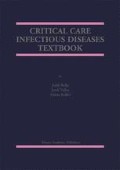Abstract
The mission of asepsia procedures in hospitals is to avoid the transmission of potentially pathogenic microorganisms from patient to patient, from health care personnel to patient, and from patient to personnel. Providing adequate health care with a high level of asepsia and at the same time interrupting the transmission of microorganisms are key steps in the attempts to reduce the incidence of nosocomial infectious diseases. The contamination of medical equipment — due either to inadequate cleaning, disinfecting or sterilizing of medical devices and environmental surfaces, or to inadequate reuse of material — exposes patients to a high risk of nosocomial infection. This risk is particularly high in the Intensive Care Unit (ICU).
Access this chapter
Tax calculation will be finalised at checkout
Purchases are for personal use only
Preview
Unable to display preview. Download preview PDF.
References
Meenhorst PI, Reingold AL, Groothvis DG. Water-related nosocomial pneumonia caused by Legionella pneumophila serogroup 1 and 10. J Infect Dis 152:356, 1985.
Armon PM, Chou T, Weil D. Nosocomial Legionnaire’s disease caused by aerosolized tap water from respiratory device. J Infect Dis 146: 460, 1982.
Irwin RS, Demers RR, Pratter MR. An outbreak of Acinetobacter infection associated with the use of a ventilator spirometer. Respir Care 25:232, 1980.
Cefai C, Richards J, Gould FK. An outbreak of Acinetobacter respiratory tract infection resulting from incomplete disinfection of ventilatory equipment. J Hosp Infect 15:177, 1990.
Reeves DS, Brown NM. Mycobacterial contamination of fiberoptic bronchoscopes. J Hosp Infect 30(suppl):531, 1995.
Spach DH, Silverstein FE, Stamm WE. Transmission of infection by gastrointestinal endoscopy and bronchoscopy. Ann Intern Med 118:117, 1993.
Weber DJ, Wilson MB, Rutala WA, Thomann CA. Manual ventilation bags as a source of bacterial colonization of intubated patients. Am Rev Respir Dis 142:892, 1990.
Gauthier DK, Long M. Colonization of mechanical ventilation bags during use. Am J Infect Control 22:358, 1994.
Hanson PJV, Chadwick EP, Gaya H, Collins JV. A study of gluteraldehyde disinfection of fiberoptic bronchoscopes experimentally contaminated with Mycobacterium tuberculosis. J Hosp Infect 22: 137, 1992.
Hanson PJV, Gor D, Clarke JR. Recovery of the human immunodeficiency virus from fiberoptic bronchoscopes. Thorax 46:410, 1991.
Spaulding EH. Chemical disinfection of medical and surgical materials. In Lawrence CA, Block SS (eds). Disinfection, Sterilization and Preservation. Philadelphia: Lea & Febiger, 1968:517.
Favero MS, Bond WW. Chemical disinfection of medical and surgical materials. In Block SS (ed). Disinfection, Sterilization and Preservation. 4th edn, Philadelpia: Lea & Febiger, 1991:617.
Rutala WA. APIC guideline for selection and use of disinfectants. Am J Infect Control 2:99, 1990.
Garner JS, Favero MS. CDC guidelines for hand washing and hospital environment control. Infect Control 7:231, 1986.
The Hospital Infection Control Practices Advisory Committee (HICPAC). Guideline for prevention of nosocomial pneumonia. Am J Infect Control 22:247, 1994.
Martin MA, Reichelderfer M. APIC guideline for infection prevention and control in flexible endoscopy. Am J Infect Control 22:19, 1994.
Editor information
Editors and Affiliations
Rights and permissions
Copyright information
© 2001 Springer Science+Business Media New York
About this chapter
Cite this chapter
Sallés, M., Ricart, M. (2001). Sterilization and Disinfection in the ICU. In: Rello, J., Valles, J., Kollef, M.H. (eds) Critical Care Infectious Diseases Textbook. Springer, Boston, MA. https://doi.org/10.1007/978-1-4615-1679-8_19
Download citation
DOI: https://doi.org/10.1007/978-1-4615-1679-8_19
Publisher Name: Springer, Boston, MA
Print ISBN: 978-1-4613-5674-5
Online ISBN: 978-1-4615-1679-8
eBook Packages: Springer Book Archive

